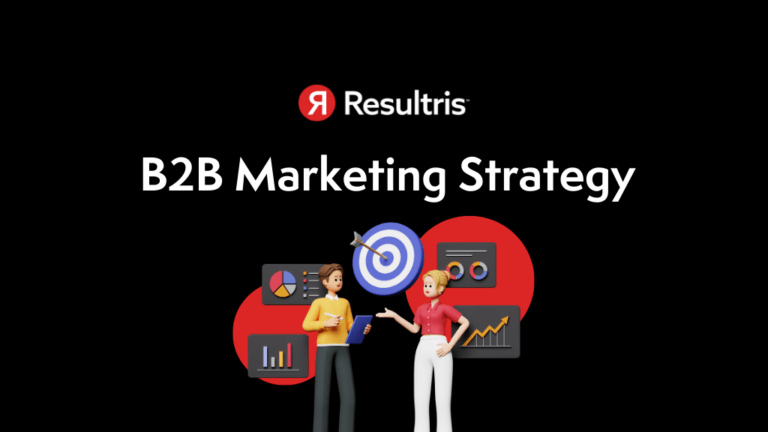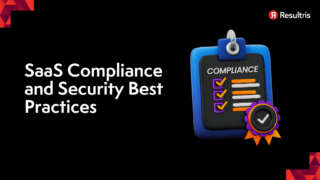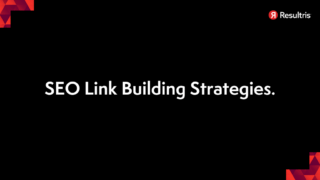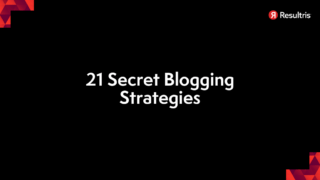

So, you’ve built a fantastic SaaS product. But as you probably already know, even the best products won’t sell themselves. That’s where a solid B2B marketing strategy steps in, as crucial to your business as a good barista is to your morning routine.
A B2B marketing strategy is a detailed plan that a business uses to target, engage, and convert other businesses into customers. It outlines tactics for identifying potential customers, understanding their needs, and positioning the company’s products or services as the optimal solution.
Key elements include defining target markets, establishing a value proposition, and choosing appropriate marketing channels. It’s geared towards long-term relationships, and high-value transactions, and involves multiple decision-makers.
B2B (Business-to-Business) and B2C (Business-to-Consumer) marketing differ primarily in their target audience, purchasing process, and marketing tactics.
Target Audience: B2B markets are smaller and more specialized, targeting organizations or professionals, while B2C targets individual consumers.
Purchasing Process: B2B purchases often involve more decision-makers, a longer sales cycle, and higher transaction values. In contrast, B2C purchases are generally simpler, quicker, and lower in value.
Marketing Tactics: B2B marketing emphasizes product features, return on investment, and long-term relationships, using channels like LinkedIn, webinars, and whitepapers. B2C focuses more on product benefits, emotional appeal, and branding, leveraging platforms like Instagram, TV ads, and influencers.
Grasping the full spectrum of B2B SaaS market dynamics is a fundamental step in concocting an effective marketing strategy.
This landscape is far from static, characterized by continuous evolution in technology, customer preferences, competitive forces, and regulatory changes.
Your approach to navigating this terrain should be as dynamic and adaptable as the market itself.
Subscription Model Dynamics: Unlike traditional product-based sales models, SaaS operates on a subscription basis. This has significant implications for your revenue generation, with a more predictable and recurring revenue stream.
It also means a continuous need for customer engagement and retention. Winning a customer is just the beginning. Keeping them happy, engaged, and subscribed is the marathon you have to run.
The Long Sales Cycle: B2B SaaS sales are not typically quick transactions. They involve long sales cycles, multiple decision-makers, various approval levels, budget considerations, and technical evaluations.
It’s crucial to understand that patience, persistence, and consistent nurturing are key ingredients in your marketing strategy.
Competitive Landscape: The SaaS marketplace is a crowded one, filled with competitors vying for the same prospects. Standing out requires more than just a unique value proposition.
It requires continuous innovation, stellar customer service, and an agile approach to market changes.
Customer Expectations: Today’s customers are informed, and discerning, and demand exceptional experiences. They expect not just a service, but a partnership that offers continuous value, support, and improvement. Meeting and exceeding these expectations can be your competitive edge.
Regulatory Compliance: Given the nature of SaaS offerings, often dealing with sensitive data, understanding and adhering to various compliance requirements (like GDPR or HIPAA, for instance) is a non-negotiable part of your marketing and operational strategy.
Navigating through the dance of B2B SaaS market dynamics requires agility, strategic foresight, and an unwavering focus on customer success.
With these ingredients, you can keep up with the rhythm of this vibrant market and turn these dynamics into opportunities for growth.
Getting serious for a moment, let’s get into the nitty-gritty, the building blocks, the LEGO of your B2B marketing strategy:
The foundation of effective marketing lies in the profound understanding of your audience and the market scope. This includes identifying the TAM or Total Addressable Market, which represents the maximum potential revenue your SaaS business could generate if it achieved full market penetration. Knowing your TAM not only guides strategic decisions but also helps in setting realistic growth goals and appealing to potential investors.
However, conquering your entire TAM right off the bat is typically not feasible, especially for startups and small businesses. It becomes critical to “niche down” and identify your ideal customers within this broader market. These are the businesses that will benefit most from your product and have the highest likelihood of becoming paying customers.
Start by defining broad characteristics like company size, industry, job role, and geographical location. For instance, your target audience could be small to medium-sized businesses in the tech industry based in North America. But don’t stop there.
Delve deeper into behavioral aspects, such as their goals, challenges, preferences, and decision-making processes. For example, if you’re offering a productivity tool, your ideal customer might be a small business owner struggling with time management and looking to streamline operations.
Using tools like Google Analytics, surveys, and customer interviews can provide valuable insights for this segmentation process. From this data, create detailed SaaS buyer personas. These semi-fictional characters represent your typical customers and help humanize your marketing messages.
By targeting these specific SaaS buyer personas, your marketing efforts will be geared towards those who are most likely to derive value from your product, effectively translating into a successful strategy. Remember, your initial niche does not limit your growth; it merely provides a focused starting point. As you grow and evolve, so too can your target audience.
Well-defined, measurable, and realistic goals should guide your marketing strategy. Start by assessing where you currently stand in terms of key performance indicators (KPIs) such as Monthly Recurring Revenue (MRR), Customer Acquisition Cost (CAC), Lifetime Value (LTV), churn rate, and conversion rates. Use these metrics as a baseline to identify improvement areas and set your marketing objectives.
For example, if your current churn rate is higher than the industry average, one of your goals might be to reduce it by a certain percentage. Similarly, if your CAC is high, you might aim to optimize your marketing efficiency and lower this cost.
Next, align your marketing goals with your overall business objectives. If your company’s goal is to penetrate a new market segment, then your marketing goal could be increasing awareness and lead generation within that segment.
Remember to set SMART goals – Specific, Measurable, Achievable, Relevant, and Time-bound. This framework will help ensure your goals are clear, trackable, and aligned with your strategic objectives.
Setting your marketing goals is not a one-time event but an ongoing process. As your business evolves, your goals will need to be revisited, adjusted, or even completely changed. Regularly reviewing and tracking your progress towards these goals will help you stay focused, make necessary adjustments, and ultimately drive your marketing success.

Content marketing subscriptions to grow your business.
Need help creating content for your SaaS marketing? Resultris can help you. Over 15 years experience in SaaS.
Increase Brand Awareness: In the early stages, you need to make your target audience aware of your presence and the solutions you provide. Through PR, content marketing, SEO, and social media, you can start building brand recognition.
Boost Lead Generation: Once you’ve raised awareness, the next step is to start converting that awareness into leads. Develop a robust content strategy and leverage digital marketing techniques like inbound marketing, SEO, and social media engagement to attract potential customers.
Improve Conversion Rates: After generating leads, focus on converting them into paying customers. This might involve improving your sales processes, creating compelling product demos, or providing exceptional customer experiences during free trials.
Increase Monthly Recurring Revenue (MRR): With conversions coming in, aim to increase your MRR. This will serve as your baseline revenue goal. Look at your pricing tiers and see where you can potentially upsell or cross-sell to increase this metric.
Decrease Churn Rate: As you start to acquire a steady stream of customers, it’s crucial to retain them. Focus on providing exceptional customer service, nurturing ongoing customer relationships, and consistently delivering value to your users.
Reduce Customer Acquisition Cost (CAC): Over time, you’ll want to make your marketing and sales processes more efficient. By reducing your CAC, you’ll improve your profitability and be able to reinvest more into your growth.
Increase Customer Lifetime Value (LTV): Once your retention strategies are in place, aim to increase the total revenue you generate from each customer. This might involve introducing higher-value tiers of service, offering premium features, or simply improving your service to increase customer satisfaction and retention.
Expand Market Share: Finally, with a solid customer base and a profitable business model, you can aim to expand. Whether that means targeting new demographics, breaking into new geographical markets, or even acquiring competitors will depend on your specific circumstances.
When it comes to setting revenue goals, think in reverse. Define the total amount of revenue you want to generate within a specific timeframe. Then, break it down into what that means in terms of the number of customers needed, the average revenue per user (ARPU), and so on. This will give you more granular targets to aim for and will make it easier to track your progress.
In the bustling SaaS marketplace, differentiating your product from the competition is vital. Here, your value proposition, positioning, and messaging come into play as powerful tools to carve out your unique place in the market.
Remember, your value proposition, positioning, and messaging are not static. They need to evolve with your business, your market, and your customers. Regularly revisit and refine these elements to ensure they stay relevant, resonate with your target audience, and give you a competitive edge.
Content is an indispensable part of a successful B2B marketing strategy. It’s the engine that drives inbound marketing, pulling prospective customers into your brand’s sphere of influence and keeping them engaged over time. However, it’s not just about creating any content; it’s about delivering the right content to the right people at the right time. Here’s how you can tailor your content for each stage of the SaaS marketing funnel:
Awareness Stage: This is where potential customers first encounter your brand. They’re beginning to realize they have a problem that needs a solution, but they’re not yet sure what that solution might be. Your goal at this stage is to provide educational content that helps them understand their problem. This could include:
We have a detailed blog post about developing your Saas blogging strategy that give you an in-depth look at what that might look like.
Consideration Stage: At this stage, potential customers are evaluating different solutions to their problem. They know what they need, and they’re trying to find the best solution. Your goal is to position your product as that solution. Content that can help here includes:
Decision Stage: Here, potential customers are ready to make a purchase decision. They’ve narrowed down their options, and your product is in the running. Your goal is to convince them that your solution is the best choice. This can be done through:
Retention Stage: After the purchase, your focus shifts to keeping your customers satisfied and engaged. Providing continuous value is key to reducing churn and fostering loyalty. For this, consider:
Advocacy Stage: Happy customers can become powerful advocates for your brand. Encouraging these customers to share their positive experiences can lead to valuable word-of-mouth marketing. To facilitate this:
In each stage, your content marketing strategy should align with your brand messaging and value proposition. The right content not only attracts and retains customers but also establishes your brand as a thought leader in the SaaS industry. Remember, content is not just a marketing tool; it’s a way to deliver value, build relationships, and make your brand indispensable to your customers.
SEO is a critical component of your B2B marketing strategy. It improves your website’s visibility on search engines, leading to higher organic traffic.
Start by conducting keyword research. Identify terms your target audience uses when looking for products or information related to your niche. Use SEO tools like Ahrefs, SEMRush, or Google Keyword Planner for this purpose.
Once you have a list of keywords, integrate them naturally into your website content, meta descriptions, and title tags.
But remember, while keywords are important, they are not everything. Search engines favor high-quality, user-friendly content. So focus on creating content that provides value to your audience.
When organic strategies aren’t enough, PPC campaigns can offer a significant boost. These paid ads appear on search engine results pages and social media feeds, offering prominent visibility to your SaaS product.
Before launching a PPC campaign, define your goals. Are you looking to increase brand awareness, drive traffic, or boost conversions? Each goal might require a different approach.
Next, choose the right platform. Google Ads is a popular choice due to its wide reach, but depending on your audience, LinkedIn Ads or even Facebook Ads might be more effective.
Then, create compelling ad copy that speaks to your value proposition and prompts action. Finally, monitor your campaigns closely. Use A/B testing to identify high-performing elements and optimize accordingly for better ROI.
A strong B2B marketing strategy is a must. By understanding your audience, communicating your unique value, leveraging content, optimizing for search engines, and utilizing paid advertising, you can elevate your SaaS marketing game.
Just like updating your wardrobe with the latest fashion trends, it’s vital to stay up-to-date with modern B2B marketing techniques. Here’s the lowdown on the latest:
Account-based marketing (ABM) is a targeted approach to B2B marketing in which resources are focused on a specific set of accounts. It flips the traditional marketing funnel by starting with who you want to sell to and then tailoring a unique strategy for each target.
In ABM, you identify high-value prospects or existing customer accounts, research these companies deeply to understand their specific needs, challenges, and goals, and then develop personalized marketing campaigns that address these specifics.
The key to successful ABM is close alignment between your marketing and sales teams. Collaboration ensures a unified approach toward the target accounts and provides a seamless experience for the customer. Use ABM platforms such as Demandbase or Terminus to simplify and scale your ABM efforts.
Marketing automation helps streamline, automate, and measure marketing tasks and workflows, so you can increase operational efficiency and grow revenue faster.
It includes email marketing, social media posting, lead generation, and reporting.
Automation tools like Marketo, HubSpot, and Pardot can help make these tasks less manual and more efficient.
CRM (Customer Relationship Management) integration means your marketing automation software and CRM system communicate with each other and share information.
This synchronization provides a comprehensive view of prospects and customers, enhancing segmentation, personalization, lead scoring, and customer engagement.
It gives a unified customer experience, from the first point of contact through customer acquisition and beyond.
Social selling is the process of leveraging your social network to find the right prospects, build trusted relationships, and ultimately, achieve your sales goals.
It’s about sparking meaningful conversations with potential customers, not just broadcasting sales pitches on social media.
LinkedIn is a particularly effective platform for social selling in the B2B world.
To succeed in social selling, listen to your audience, engage them with valuable content, and nurture relationships.
Tools like LinkedIn Sales Navigator can help identify prospects, track interactions, and gather insights.
Influencer partnerships, on the other hand, involve partnering with thought leaders in your industry to boost your brand’s credibility and reach.
Influencers can help you create content, promote your product, or even collaborate on events. This gives you access to their loyal audience, which can speed up trust-building and conversion processes.
Remember, the right influencer isn’t necessarily the one with the most followers, but the one who has the trust and attention of the audience you want to reach.
Tools like BuzzSumo can help identify potential influencer partners.
ABM, marketing automation and CRM integration, and social selling & influencer partnerships are powerful strategies that can take your B2B marketing strategy to the next level.
By adopting these approaches, you can create a more targeted, efficient, and influential marketing strategy for your SaaS company.
Customer success is no longer a mere function or a department—it’s the heart of an effective B2B SaaS marketing strategy.
It revolves around understanding your customers’ goals and needs, delivering on those expectations, and providing value that goes beyond the software itself.
The goal of customer success is not just to retain customers, but to turn them into advocates for your brand.
This makes the role of customer success pivotal. Successful customers are loyal, renew their subscriptions, expand their usage, and recommend your product to others.
They offer authentic, relatable insights into the benefits and results of your product. Tools like Trustpilot or G2 can help gather and manage customer reviews.
Regularly share customer success stories and feedback with your team to remind them of the “why” behind their work.
This allows you to proactively address issues, celebrate successes, and personalize customer interactions at scale.
This empowers customers, reduces support requests, and fosters a community of loyal, knowledgeable users. Platforms like Zendesk Guide or Vanilla Forums can facilitate this.
Remember, customer success isn’t about firefighting problems; it’s about fuelling success. The more successful your customers are, the more successful you will be.
In the world of B2B SaaS marketing, nothing speaks louder than the success of your customers.
To round it all off, let’s talk about measuring your success. Without numbers to guide us, a marketing strategy is just shooting in the dark (and we’re not making a suspense thriller here).
KPIs are critical in measuring the effectiveness of your marketing strategy. They help you understand what’s working, what’s not, and where to direct your efforts.
In SaaS B2B Marketing, some key metrics include:
Use these KPIs to continually monitor and optimize your marketing efforts. Employ analytics platforms like Google Analytics, Mixpanel, or Tableau for detailed and efficient tracking.
Feedback loops are mechanisms for collecting customer insights and using them to improve your product and marketing strategy. This could involve surveys, user testing, interviews, or reviews.
Regular feedback from your customers gives you firsthand knowledge of what they like, dislike, need, and expect from your product. This insight allows you to address issues promptly, make strategic adjustments, and improve customer satisfaction.
Tools like SurveyMonkey, UserTesting, or Intercom can facilitate collecting and managing customer feedback.
Don’t view feedback as criticism; see it as a goldmine of information that can drive your product and strategy development. And remember, the most valuable feedback often comes from your most dissatisfied customers.
In the fast-paced SaaS industry, the ability to learn quickly and adapt is crucial. Market conditions, industry trends, and customer preferences change constantly. Your capacity to identify these changes and tweak your marketing strategy accordingly will set you apart from competitors.
Stay informed about industry trends by reading trusted SaaS and marketing publications, attending webinars and conferences, and networking with industry peers. Keep a close eye on your competition to identify any new strategies or tactics they’re employing.
Experiment with different approaches, track the results, and don’t be afraid to change course if something isn’t working. The ability to learn from mistakes and iterate quickly is often what separates the most successful SaaS companies from the rest.
The use of KPIs, feedback loops, and continuous learning and adaptation are integral parts of a robust B2B marketing strategy. They are the mechanisms that allow you to measure, learn, and improve your marketing efforts in a consistent and systematic way.
As we step into the future, B2B content marketing for SaaS companies will continue to evolve faster than your favorite streaming service churns out seasons.
From AI-powered tools to hyper-personalized experiences, there’s a lot brewing in the pot.
But remember, while trends come and go, the core principles of understanding your customers and delivering value will always remain in style – much like the timeless little black dress in your wardrobe.
In this complex dance of SaaS B2B marketing, we’ve learned to twirl, swing, and occasionally cha-cha.
From understanding the unique dynamics of the SaaS market, to sprinkling magic dust on your content, and even adding a dash of modern marketing techniques to the mix, there’s a lot you can do.
Don’t forget to measure your steps, learn from the occasional missteps, and always keep your eyes on the prize.
Now it’s your turn to put on your dancing shoes and waltz into the arena of B2B marketing strategy.
Consider the tools, strategies, and insights shared here as your secret choreography. Now go on, and make some beautiful marketing moves.
Oh, and do return to our blog for more insights faster than you’d click ‘next episode’ on a cliffhanger!




